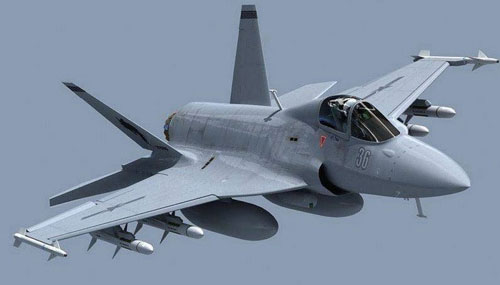Salahuddin Haider
PAKISTAN Air Force combat aircraft plant at Kamra has taken a major step forward self sufficiency by rolling out two such highly precision combat aircraft out of its plant in Kamra and hopes to move forward with speed toward making self reliance in its search for advancement and self reliance. At the moment interest on the JF-17 Block 3 are countries like Argentina, some Eastern European countries, Azerbaijan, Turkeminstan, Malaysia, Indonesia, Nigeria, Sudan, Egypt, Iran, Uzbekistan and Botswana.
The Block 3 is the latest because of more advance avionics, improved BVR weapons and Helmet Mounted System (HMS). This would bring the jet towards 4+ generation fighter level.
At a price of US$30 million each, it is considered the most affordable light fighter and currently it is fighting with competitor products like the South Korean FA-50 Block 20 as well as the Indian Tejas Mk.2 and Chinese L-15B and the FTC-2000G. The JF-17 could be a potential low cost alternative for nations looking for affordability, no strings attach for purchases. European, US and Russian fighters are expensive to buy and own.
The Pakistani Thunder jet is one alternative for any air force facing restriction as well as large ownership cost. At $30 million each, it will face various jets kn market today. The South Korean FA-50 is a serious contender in today’s light fighter and advance trainer market. Its an ideal platform to replace the legendary F-5E Tiger II. The Block 20 with AESA radar and BVR capability will be priced at $35 million each The FTC-2000G is another alternative multi role jet based on the MIG-21 and J/F-7 airframe but has instead a solid nose and side intake. SUDAN is one of the customers for this jet. This could be another alternative which is priced at $18 million each.
The L-15B is a high Mach jet with similar speed to the JF-17 and FA-50. It has a real potential to disrupt the LIFT and light fighter market priced at $16 million each. Many countries are looking at the L-15b due to its performance and weapons fit as well as twin engine configuration. This jet could be a disruptive product for the JF-17 however.
The JF-17 Block 3 will be equipped with AESA radar, IRST, HMS, BVR missiles and will have a solid support from Pakistan and China. Pakistan is key to develop an efficient infrastructure to support the product on a global scale. Nigeria is one country to buy 3 jets for testing with expectations more to be ordered once the jet qualifies and meet Nigerian air force requirements.










